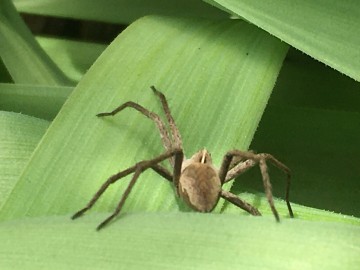![]() This page is regularly updated, please select here to view the latest version.
This page is regularly updated, please select here to view the latest version.
April 2022 - Nursery Web Spider
April 22
The Nursery Web Spider
 I was gardening in the central bed when I spotted this wee beastie seemingly enjoying the sunshine. She stayed still long enough for me to take a photograph, but clearly decided it wasn’t for her, and in the second photo she’s turned her back and is heading for cover.
I was gardening in the central bed when I spotted this wee beastie seemingly enjoying the sunshine. She stayed still long enough for me to take a photograph, but clearly decided it wasn’t for her, and in the second photo she’s turned her back and is heading for cover.
Unbeknown to me at the time, I also took photos of the male of the species. I just happened to notice that there were a number of spiders scuttling around amongst the ‘weeds’ on the edge of small parking area.
When I got home and consulted the oracle (AKA Google) I discovered that these are Nursery Web spiders. They are apparently very common, but nevertheless fascinating.  The female is larger than the male, her body size being 12-15mm and described as cigar shaped. She has long, robust legs and typically, the front 2 pairs are outstretched in line with the body and held closely together (as per photo). Another identifying feature is the dark stripe with a central white line that runs down the back of the head and thorax. The male is smaller at only 10-13mm and distinguished by having thickened pedipalps, which look like miniature boxing gloves (see photo); the palps being appendages between the jaws and first pair of legs. Whilst these occur in both sexes, they are thickened in the male because they carry the sperm.
The female is larger than the male, her body size being 12-15mm and described as cigar shaped. She has long, robust legs and typically, the front 2 pairs are outstretched in line with the body and held closely together (as per photo). Another identifying feature is the dark stripe with a central white line that runs down the back of the head and thorax. The male is smaller at only 10-13mm and distinguished by having thickened pedipalps, which look like miniature boxing gloves (see photo); the palps being appendages between the jaws and first pair of legs. Whilst these occur in both sexes, they are thickened in the male because they carry the sperm.
This species doesn’t use a web to capture its prey, it’s an active hunter that feeds on flies and other insects. It relies on its speed and strength to overcome its prey.
The reproductive behaviour of Nursery Web spiders is particularly interesting. Research has shown that males who present females with a tasty gift wrapped in a silken thread, stand the best chance in the mating game. Occasionally the male will attempt to ‘deceive’ the female by using odd bits of plant material or insect debris, in the hope that before she’s able to detect the ruse, he can move in and mate with her. If the female
shows any signs of aggression, the male will ‘freeze’ and appear as if dead; a protective mechanism to try to avoid becoming the prey himself. After mating, the female lays her eggs into a large silk cocoon which she carries around in her jaws. Just as the eggs are about to hatch, she attaches the sac to a blade of grass, in amongst the vegetation, and builds a dense nursery tent around it. This silken web protects the spiderlings as they undergo their first moult prior to leaving the nest. The mother will stay close by until all the spiderlings have dispersed.
So next time you’re at the Rec see if you can spot this fabulous spider. You may even be lucky enough to see the female carrying her egg sac or some of the nursery tents which are usually around between mid June and July. And isn’t it amazing to think that all this drama is going on right under our very noses!
Words and pictures by Denise Long
Click any image to enlarge
![]()


